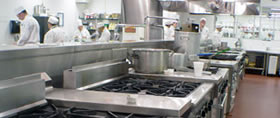|
 |
|||||||||
|
|
|||||||||
|
Health Inspectors in over 3,000 local health departments do inspections to assure safe food and sanitary conditions in restaurants. Unfortunately a inspection only detects errors after they have occurred, and customers might already be sick from an untrained team member. Inspections should be only a minor element of a food safety program that puts the most emphasis on properly trained food handlers, a safe supply system, and capable managers. Having a restaurant with a health permit and no "safe food" training is like a "license to kill". Furthermore properly maintained and updated equipment is a must to ensure a safe and adequate work environment for your staff. The following handbooks and brochures are available for download in Adobe Acrobat Format and can help in training your staff and evaluating your current practices.
Please note that in order to read and print the documents on this page you must have the latest version of the Adobe Acrobat Reader installed on your computer. You can obtain a free copy from Adobe by clicking on the icon on the below. |
|
|
|
||||||
|
Learn more about the most popular wine varieties and appellations from our wine resource guide. |
|||||||||
|
More
information: |
|||||||||
|
More
information: |
|||||||||
|
Many servers do not sell wine because they are not experienced in opening wine bottles. Some dry training can help them overcome the fear of "missing a step" at the table. |
|||||||||
| Home | Mission Statement | Services | Resources | Contact | Industry Links |
| © 2005 tableside hospitality consulting |
|
|